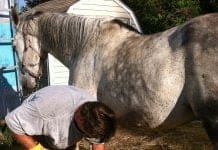
I’ve learned most of my cusswords from experiences with horses who either wouldn’t load in the trailer, or once loaded, proceeded to tear the trailer and themselves to pieces. Nothing tests a man’s patience quite like a horse. I’ve seen grown men pound their fists on the ground (might have been me) when a horse won’t load. This usually happens when you just don’t have time to deal with the situation and tempers flare. The solution is to train your horse to load in an unpressured environment. Trying to get a cranky horse to load after you’ve spent eight days in the backcountry alone is never a good situation for the rider or the horse.
Here’s a quick video on the system I use to load horses. My two-horse Miley trailer is 35 years old and is much smaller than the newer versions. Horsemen of today have it a little easier with the roomy slant load trailers, but you’ll still have to spend time training your horse. Horses that aren’t trained to load are downright dangerous to themselves and everyone around.
I don’t mention it in the video, but never tie a horse in a trailer until you’ve secured him from backing up. Most trailers have a chain or door that prevents this- use them! You’ll see in the video that is the first thing I do once the horse is loaded. There is something very frightful to a horse that is tied in a trailer and then tries to back up unrestrained from behind. If you forget this step, you’ll likely get to visit the veterinarian or worse, the hospital.
Feel free to share any tips or experiences you have in the comments section.




















Back when my Dad and I took horses into the mountains, loading horses was definitely one of the trickier parts of the horse experience. We had a trailer much like yours (no loading ramp though), and the horses often didn’t like loading. We did pretty much exactly what you showed, and practiced lots with the horses before heading out. Ocassionally, we had to resort to a last ditch method to get them in. Tie a long rope, about 3 feet up, to the opposite side of the stall you’re not putting your horse in. Lay it flat on the ground in a large loop so it extends to where you will be standing (and behind where the horse will be standing behind the trailer), on the loading side when holding the halter after going through the trailer. If the horse won’t load, lift up the rope and bring it up behind their hind end. They don’t like that, and may kick (so don’t be standing behind them), but they usually load pretty well then. They really don’t like that rope behind them, and the trailer becomes the safe place to be to get away from it. Works better with 2 people, but can work with one. I’m not explaining this very well, hope it makes sense.
We had a particular stubborn horse that wouldn’t train at all to the trailer, and we tried everything! This was the method we found out about to use on him, and it worked. Works really well on stubborn horses.
You explained it well! And I’ve seen that trick before. It works.
Robby, you don’t like mules? haha!
What kind of horses do you hunt with?
Have you ever had mules, or just decided to stick with horses?
Thanks for the video!
The molly mule I got this spring wouldn’t load at all for the life of me. always put up a fuss and fight.
Well with time and patience (not really on my part..anger) she now will walk right in on her own. I guess she decided it wasn’t such a big deal or something, its like a switch flipped for her. Mules are funny that way.
Do you remember your deer hunt from last year with horses? I liked that video…
Each year, I struggle trying to get my weights even on the pack bags and dealing with long steep packs in/out and keeping stuff from shifting and moving too much. I have to stop and readjust every couple miles it seems. Maybe you could go through how you set up your pack horse and what you pack for your hunts—all your gear and why you take what you do.. Maybe some knots you use for certain things, etc.
Couple questions, do you run a highline for your horses when at camp? or just a leg hobble and stake out? Do you usually take in food for them, or can you get by for the hunt in most areas? Do you run britchens on your horses, or cruppers?
Hi Neal. Actually, I do like mules and have packed with guys who have them-they’re a great animal. However, my daddy set me on the path of horses as a very young boy, so that is what I know. I’m sure I’d do fine with mules, just happy with horses for now.
You ask some great questions and I will address them on the blog as we get into hunting season. For now, I’d say you having to “readjust every couple miles” is because your packs are either not weighed and balanced (must be within 3 pounds of each other), or you’re not securing them so they don’t bounce and work the rope loose. I weigh my packs with a small scale even in the backcountry and that solves 90% of the problems. If I get my packs tied right (I use a basket hitch), I’ve ridden 15 miles in hard country without having to retie. I’ll get to these topics as soon as I can. Thanks!
Comments are closed.